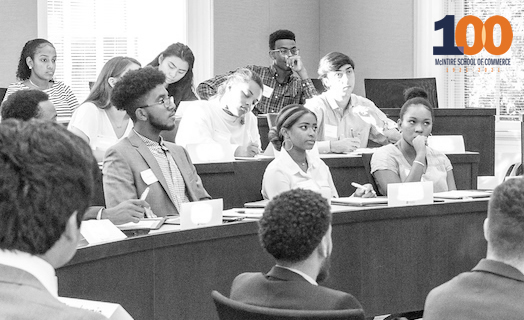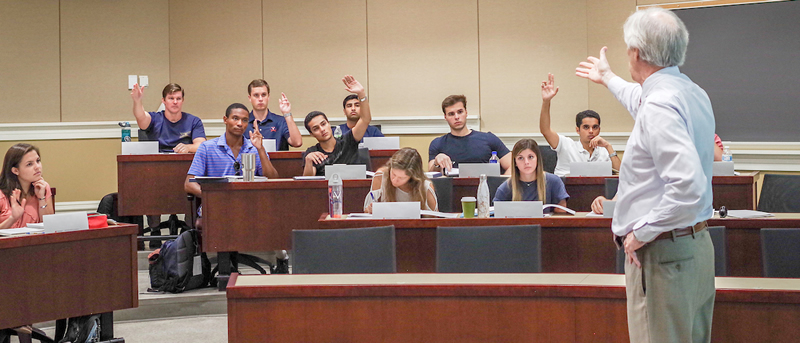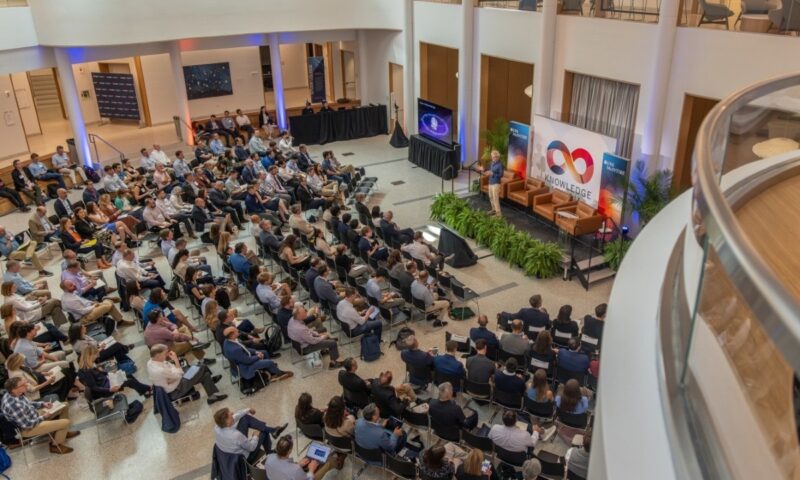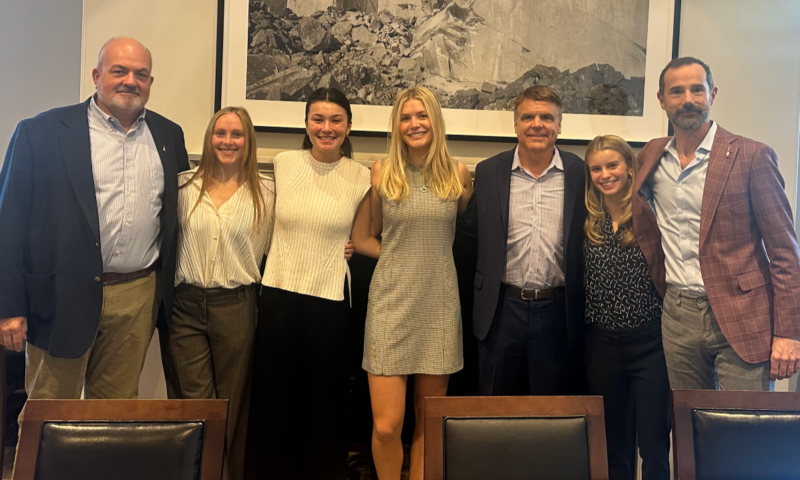 McIntire has long been regarded for its innovative approach to global business education across all of its undergraduate, graduate, and certificate programs. Yet perhaps no aspects of the many learning experiences developed by the Commerce School have come to define it as stoutly as the Integrated Core Experience.
McIntire has long been regarded for its innovative approach to global business education across all of its undergraduate, graduate, and certificate programs. Yet perhaps no aspects of the many learning experiences developed by the Commerce School have come to define it as stoutly as the Integrated Core Experience.
How did it become the School’s hallmark program? Emphasizing the development of analytical, strategic, and behavioral skills across multiple academic disciplines that address real business problems, the third-year curriculum is readily cited as fundamental to the professional success enjoyed by all students involved, from new alumni to those who went through the earliest iterations of the program.
The Integrated Core Experience was introduced in the fall of 1999 by former Dean Carl Zeithaml, former Associate Dean Mike Atchison, and a dedicated group of their colleagues, supported by a $450,000 grant from the GE Fund to underwrite its initial development. This insightful faculty team orchestrated a prototype of what would become the seminal program it is today. With the model focused on two of the eight sections of 40 third-year students each, some jealousies among students emerged; those who were not included may have rightfully felt they were missing out on a revolutionary learning concept. Although the faculty initially approved a two-year trial of the Integrated Core Experience, the extremely positive response from the two student sections involved, coupled with the overall reaction of all third-years, led the faculty to vote in favor of extending the program to all eight sections in the following year.
Students engaged in a coherent series of courses stressing foundational concepts, real-world practice, effective teamwork, and a cross-functional approach reflecting current business issues and practices. The inventive pedagogy focused on gaining an in-depth understanding of the functions and issues of enterprises across industries, and has been continually reevaluated, updated, and enhanced by faculty since its launch, integrating seven curriculum areas (strategy, systems, organizational behavior, marketing, communication, quantitative analysis, and finance) through five courses.
During the fall, third-years take Strategy and Systems; Behavioral Issues in Marketing and Management; and Quantitative and Financial Analysis, collaborating with each other to present well-crafted business ideas to representatives of the School’s corporate sponsors of the Integrated Core Experience. In the spring, two courses, Strategic Value Creation and Managerial Decision Making, complete the coursework. That’s the breakdown on paper, but its achievements and fame aren’t just about five great classes.
There is much more to say about how the Integrated Core Experience extends well beyond its intended vision of unifying subjects that academia had previously viewed in a more isolated way. Indeed, why the program continues to be particularly effective in preparing Comm students so well to become leaders in their chosen fields is ultimately what’s important. And though the stellar track record of student outcomes over the last two decades speaks—if not screams—for itself, it may be best to turn to those who have taught it to understand just how “ICE” has become the benchmark for business education excellence it is today.
Leading Organizational Change

Carl Zeithaml
Getting the program off the ground took a great deal more than a few faculty planning sessions and a favorable attempt at testing the format with two sections of students. Zeithaml enlisted the assistance of curriculum experts at the University’s School of Education and Teaching Resource Center to share their expertise for executing the multiple facets of the intricate operation behind the reimagining process. Upon preparing a schedule that planned for three years of development, the School also grappled with ensuring faculty had ample opportunities to feel confident in assuming a new perspective now that they were to analyze business holistically and teach from intersections that straddled myriad areas. The demanding initiative required Zeithaml and faculty to collaborate extensively on administrative and cultural changes; that combined effort helped to guide and coordinate faculty teams as they implemented a long list of moving parts required to work smoothly in concert in order for the program to thrive.

Ryan Nelson
“Most faculty recognized that there were opportunities to significantly improve the student learning experience in the third year, and as a result, they were excited to try out something new, something bold, that no one had tried before!” says Professor Ryan Nelson, a longtime teacher of the Systems portion of the program. He notes that while the phased approach had its pros and cons, those involved in the pilot were quickly optimistic about the potential for the Integrated Core Experience.
Though there were concerns, they were quickly allayed. During a faculty meeting, Nelson remembers, the pilot team was asked if the new “concentrated, shorter-term, modular design” of the program allowed faculty to get to know their students to the same extent made possible by the School’s previous third-year course configuration. “My response was, ‘Absolutely, and in fact, I would say that faculty get to know students even better.’”
After the program was set in motion, the assessment process for it was as robust as the design behind the Integrated Core Experience itself. Student and faculty course evaluations, exit interviews with fourth-year students, AACSB graduate surveys, and questionnaires with alumni two years and five years after graduation were completed, along with corporate advisory board reviews of both the curriculum content and its delivery methods.
“We received positive feedback from recruiters, alumni, and parents who immediately recognized the increased sophistication and understanding of students for complex business topics,” says Nelson, recalling, as an example, that students who had been part of the program proved themselves routinely capable of discussing many integrated business topics in their internship interviews.
With the response being overwhelmingly positive among all parties involved, the Integrated Core Experience was on its way to providing the wide-ranging skills set its architects intended.
Exceptional Flexibility and Ongoing Innovation
Once all eight sections of the third-year students were participating in the program, an arrangement was created to group faculty into four teams, with each teaching two student sections, known within the program as blocks.

Christi Lockwood
“Teaching as part of a faculty team that covers virtually all disciplines in the School of Commerce is incredibly unique and offers faculty and students the chance to develop a truly holistic, well-rounded perspective,” says Professor Christi Lockwood. “As a faculty member, teaching on an ICE team affords me a view to what students are learning in their sessions on strategy, communication, marketing, and so on, such that I can tailor my lessons to link with those of other faculty members. This really enriches the teaching experience for me, especially as someone who conducts research that connects closely with other disciplines, and allows me to think more ‘big picture’ about the content I deliver than I might otherwise.”

Gary Ballinger
Professor Gary Ballinger, who has been teaching Organizational Behavior as part of Team 1 since 2005, agrees.
“The integration comes from the fact that the instructor knows what has been taught in all of the other disciplines at a particular time,” he says, clarifying that the format also allows for better collaboration among faculty members in the same discipline to determine what is being taught in his subject versus what topics they decide to exclude—all while considering the overall student workload.

Felicia Marston
“What I remember most was how much ICE benefited me and worked at the faculty level,” says Professor Felicia Marston. “I really enjoyed getting to know and collaborating with colleagues on teaching across disciplines. I learned so much about strategy from Adelaide [Wilcox King]—and that has helped my teaching beyond ICE. Even after I rotated out of the program, I felt my other courses benefited from the fact that I knew what kinds of things they were studying across disciplines, and I had a better perspective of finance’s role within the whole corporation.”

Jeff Boichuk
Having taught in the program since fall of 2016, Professor Jeff Boichuk says he’s come to love its collaborative nature. “There’s something special about co-creating a comprehensive set of courses with a team of faculty members.”
Nelson says that the basic principles of that integration, along with team-teaching, a balance of hard and soft skills, global topics, and the modular format, have all stayed the same. Individual topics have evolved to fit the changes in the business environment and demands on students, which he says has led to the introduction of new modules during the spring semester. “The beauty of ICE is that it is extremely flexible, allowing faculty to add, modify, and delete topics over time to make sure that students are prepared for advanced classes, internships, and careers.”
Due to its iterative construction, the development of the program has been ongoing, a process ensured by the constant content review by faculty.
As such, the construction of the classes themselves also continues to evolve.

David Lehman
Professor David Lehman says he has seen various portions of the program transformed since he joined the School in 2012. “Each of these changes has been made in an effort to keep it relevant to current trends in business. Perhaps most significantly, a revised version of Managerial Decision Making was launched in 2017,” he says, pointing out how the course combines aspects of Quantitative Analysis, Information Technology, and Organizational Behavior to help students understand how to make more effective decisions, “both individually and collectively, in the context of big data that is prevalent in organizations and society at large.”
Ballinger explains that his course employs many more hands-on learning activities than in the past. “There used to be many more case discussions than interactive exercises; now it’s probably split about 50/50. We don’t tend to do full class lectures. That’s changed. And we’ve tended to move towards a more focused effort to immerse students in particular topics for brief periods during this semester, as opposed to sort of spreading topics out through across the entire fall semester,” he says.
That development is the result of a philosophical shift based on the notion that students benefit from thinking deeply about topics when they’re presented over a shorter period of time as opposed teaching every topic across all 14 weeks.
“If you put a fall 2005 ICE calendar up against one from fall 2021, the first thing you’ll notice is that students now have a much more immersive component, deeply engaging with particular topics.”
Lockwood says that though the program is punctuated by deep dives, she reminds students that they are exposed to “a wide swath of topics from right out of the gate,” something she says most other schools’ programs don’t do, as they’re locked into a more linear sequence over the course of a few years.
Offering both comprehensive and tightly focused takes on subject matter, ICE provides flexibility that allows faculty to quickly pivot to adapt the curriculum, a trademark feature of the program.
“We tailor the curriculum each semester to the group project, which changes every year and is always centered on a contemporary issue that our corporate sponsor is facing,” says Boichuk. “The curriculum stays relevant by design.”
The Advantage of Corporate Involvement
Corporate sponsors—and the issues they face—are arguably the key to the Integrated Core Experience’s effectiveness and impact on student learning. From its start, that component has given the program real-world pertinence by fostering close collaboration with corporate sponsors and their executives who consult with students on projects each fall.
“Corporate involvement was introduced early on, when CNET volunteered to work with students on a project,” Nelson says, referencing the long-established media website and its Co-Founder and then-COO Shelby Bonnie (McIntire ’86), who helped create a relationship with those first two student sections. The project served as a blueprint for similarly styled corporate interactions as the program grew.
“It worked so well that we expanded corporate involvement in the form of sponsors to all teaching teams,” Nelson says, explaining that corporate involvement has been a great learning experience for faculty as well.
As the academic year begins, students are introduced to their block’s corporate sponsor and start to examine the firm’s financial position and strategy as the faculty team guides them through all aspects of the sponsor’s business. The next stage includes a communication assignment in which students email questions to management; these questions provide the context for a Zoom call held early on in the semester.
 Additionally, this first conversation helps lay the groundwork for the major project that defines the fall: Students develop a comprehensive new product introduction plan for the corporate sponsor to which executives lend their insights and ultimately observe and give feedback on student presentations at the end of the semester.
Additionally, this first conversation helps lay the groundwork for the major project that defines the fall: Students develop a comprehensive new product introduction plan for the corporate sponsor to which executives lend their insights and ultimately observe and give feedback on student presentations at the end of the semester.
“Each partnership has had its own benefits and success in unique ways as a result of diversity in the industries and types of businesses,” Nelson says.
The expansive list of organizations who have lent their expertise and input has ranged from Dow, Procter & Gamble, Major League Baseball, and Rolls-Royce to current corporate sponsors AB InBev, Allianz, Hilton, and CarMax.
“Corporate involvement has always been rather high in my classes at McIntire. What’s unique is that it’s a built-in feature of ICE, rather than an add-on. Oftentimes in other undergraduate business programs, corporate involvement takes the shape of one-off, sporadic guest speakers or large symposia targeted to a really diverse audience,” Lockwood says, remarking how the sponsors have extensive knowledge of how the program works. “Students are afforded an in-depth, current, and realistic view to the business problems and challenges that major companies face—and are tasked with solving some of them. In turn, our sponsors report benefiting substantially from the fresh perspective our students offer therein. It’s this unique structure and ongoing interaction that, in my view, make corporate involvement so compelling and effective in ICE.”
Ballinger, who has welcomed Virginia power company Dominion, European engineering firm ABB, and hotel leader Hilton into the classroom, says the robust and inventive life of the project has continued impeccably with Richmond, VA-based auto retailer CarMax.
“We put together the template for a project that’s been pretty durable over the last several years, in which we design and pitch products to CarMax,” Ballinger says, describing CarMax as a “test-and-learn company,” willing to try most any idea. “If it fails, it’ll fail quickly; if it works we’ll keep making it better.” In recent years, the project has helped students learn about different market segments and the buying process by interviewing customers directly.
Pausing midway through the project to evaluate the first student pitches, Ballinger says feedback from CarMax makes clear to students which of their ideas hold the most promise. “Then they start developing more advanced marketing and financial plans for those particular products. We then move on to understanding how that goes from clicks to cash, cash flow for the firm, and then how that cash flow ultimately creates value for shareholders and other stakeholders. It’s a very comprehensive project from beginning to end,” he says, stressing the critical step of corporate assessment toward impacting student ideation. “In terms of innovating and trying new things and new products, it shows students how that kind of strategic flexibility is important for survival as well.”
Perennially Rewarding
Since its adoption for all third-years, the Integrated Core Experience—and the process to develop and enhance the program—have exhibited the qualities necessary to meet the ever-changing needs of students, recruiters, and the marketplace itself. As the Commerce School enters its second century and ICE continues being refined in its third successful decade, Nelson believes that the concept behind the program’s curriculum is as powerful today as it was 20 years ago and has a role in McIntire’s prominence in higher education.
“The topics change, but the basic concepts of integration, holistic thinking, and the combination of hard and soft skills remain the same,” he says. “ICE truly differentiates the School; it sets us apart from virtually all other undergraduate business schools—in a good way!”
 His assessment is shared by many, including business education website Poets&Quants for Undergrads, which has ranked McIntire first in academic experience for years, due in large part to the strength of ICE.
His assessment is shared by many, including business education website Poets&Quants for Undergrads, which has ranked McIntire first in academic experience for years, due in large part to the strength of ICE.
Nelson says the program excels by encouraging students to approach challenges as holistic business problems and rely on functional expertise, as opposed to starting with functional, discipline-specific approaches that often fail to address overarching company goals. The approach has paid off.
“The ICE model can be complex and messy at times, but the outcomes have proven to be effective,” he notes, referencing the enduring relationships within and between student blocks, as well as its ability to connect faculty from different subject areas.
“What persists is the ability to think within the context of the whole firm,” Ballinger says. “And the notion that bringing multiple topics together and immersing students in them over the course of a semester, or even a shorter period, is still more to their benefit than simply taking all of these particular topics separately.”
Lehman believes the program’s success lies with all of the people involved who have invested their time and vision into it: “The faculty are incredibly committed to providing students with a top-notch learning experience that is not only academically rigorous but experiential and practical. The students are among the best and the brightest in the world and, just as important, hard working. The sponsors are real partners in the educational experience.”
Echoing Lehman’s views, Lockwood says that “each group does its own part to invigorate ICE, and together, they keep the program at the forefront of undergraduate business education.” She believes that since the very design of the program empowers students to explore what interests them most, it prepares them to be well-informed and positioned to fare well in their careers. Similarly, she feels that the fluidity of its design structure will allow the Commerce School to further advance what it does best.
“I feel confident that ICE will continue to adapt to meet those demands while all parties—students, faculty, corporate sponsors, administration, and alumni—hold themselves and each other to the same high standard of excellence that has always characterized ICE and McIntire.”
Boichuk says that despite its dynamism, the program possesses a rich sense of tradition that has enshrined it in the McIntire community and afforded it a great deal of positive momentum. He also regards it as inimitable for other universities.
“I can’t imagine another business school implementing a comparable program because most other faculty tend to be siloed. The groundwork that [retired] Professor Mike Atchison and others laid decades ago to muster buy-in for the program is paying dividends now that it’s become the status quo.”
Marston concludes that the Integrated Core Experience has become part of the Comm School fabric and thrived for two distinct reasons—persistence and perseverance. “There’s a willingness on the faculty’s part to revisit curriculum year after year and change things that were not working well, and a strong commitment to teaching across the McIntire faculty,” she says. “That was true when I got here over 30 years ago and is still true today. And I believe—and sure hope it continues—into the future.”


